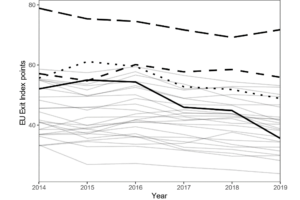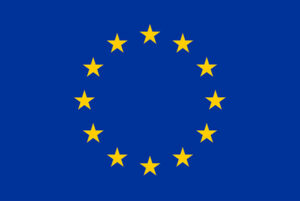THE EU EXIT INDEX: COULD ANY OTHER COUNTRIES LEAVE THE EU IN THE FUTURE?
Political scientist Markus Gastinger completed his Master’s degree in European Union Studies at the “Salzburg Centre of European Union Studies” at the PLUS in 2009. 10 years later, he returned to the PLUS as a Marie Skłodowska-Curie Fellow and has developed an “EU Exit Index” that can be used to gauge which countries are closer to leaving the EU than others.
On 31 December 2020, the United Kingdom left the European Union. This proved that it was not only theoretically possible to leave the EU. From a democratic perspective, the United Kingdom leaving the EU was a (in a way beautiful) process highlighting that the EU is a voluntary association of sovereign states that does not base its authority on the use of force. Still, the withdrawal raises the question: will other member states turn their backs on the EU, too?
Making EU exit propensities “measurable”
To answer this question, Markus Gastinger developed the “EU Exit Index”. The index is composed of social, economic and political indicators:
- Socially, he relies on survey data. For example, he assesses the share of citizens identifying exclusively with their nation state or viewing migration from other EU countries negatively. Both increase the likelihood of leaving the EU.
- Economically, the index includes, for example, how much trade takes place with other EU member states, i.e. how valuable membership in the European single market is.
- Politically, the proportion of Eurosceptic MPs in the national parliament is estimated, among other things.
- All indicators are normalized from 0 to 100, with 100 defining the maximum exit propensity.
The following graph summarises the result of the EU Exit Index for the period from 2014 to 2019. The UK is consistently at the top by a wide margin (long-dashed line at the very top). In 2015, just before the Brexit referendum, it scored 75 out of a possible 100 index points. This put it well ahead of the second-placed country. In 2015, this was Austria, which also only achieved 60 index points at the time (dotted line). Since the UK was only very narrowly in favour of leaving in the referendum result, it is likely that a country would have to achieve close to 75 index points before there is any real prospect of leaving the EU. Current stats show that every country – including Austria – is far from this score.

Future withdrawals are unlikely – but not impossible
The graph also illustrates how the EU Exit Index has changed over time. The values for Austria, for example, have been constantly decreasing since 2015. The Czech Republic’s values, on the other hand, have levelled off at a high level (short-dashed line). Since 2016, the Czech Republic has been consistently in second place behind the United Kingdom. The index has declined the most for Cyprus, which was in fourth place in 2015 but ranked in the bottom third in 2019 (solid black line). In fact, the EU Exit Index has declined almost everywhere since 2016. At this stage, there is hence no indication that more countries could leave the EU.
Markus Gastinger: “This doesn’t mean that it will stay like this forever. If the UK proves that it can live comfortably outside the EU over the next few years, more countries may begin to entertain this option. On top of this, the aftermath of the Corona pandemic could polarise society. Nevertheless, a complete collapse of the EU is hard to imagine. Most countries will probably continue to prefer a rule-based system of cooperation within the EU rather than a reorientation beyond Europe (“Global Britain”) or “splendid” isolation. In any case, the EU Exit Index makes it possible to assess any such trends and to substantiate debates on further exits in the future.”
____________________
Study (open access):
Gastinger, M. (2021) ‘Introducing the EU exit index measuring each member state’s propensity to leave the European Union’, European Union Politics
Link to the study: https://journals.sagepub.com/doi/10.1177/14651165211000138
Further information
markus-gastinger.eu | twitter.com/MarkusGastinger
____________________

This project has received funding from the European Union’s Horizon 2020 research and innovation programme under the Marie Skłodowska-Curie grant agreement No. 840135.





